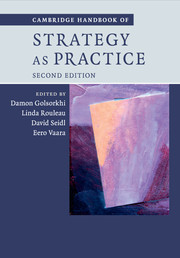Book contents
- Frontmatter
- Contents
- List of figures
- List of tables
- List of boxes
- List of contributors
- Preface to the Second Edition
- Introduction: what is strategy as practice?
- Part I Ontological and Epistemological Questions
- Part II Theoretical Resources: Social Theory
- Part III Theoretical Resources: Organization and Management Theories
- Part IV Methodological Resources
- Part V Substantive Topic Areas
- 31 Strategic planning as practice
- 32 Meetings and workshops as strategy practices
- 33 The role of materiality in the practice of strategy
- 34 Strategy-as-practice research on middle managers’ strategy work
- 35 Participation in strategy work
- 36 The role of emotions in strategizing
- Index
- References
36 - The role of emotions in strategizing
from Part V - Substantive Topic Areas
Published online by Cambridge University Press: 05 October 2015
- Frontmatter
- Contents
- List of figures
- List of tables
- List of boxes
- List of contributors
- Preface to the Second Edition
- Introduction: what is strategy as practice?
- Part I Ontological and Epistemological Questions
- Part II Theoretical Resources: Social Theory
- Part III Theoretical Resources: Organization and Management Theories
- Part IV Methodological Resources
- Part V Substantive Topic Areas
- 31 Strategic planning as practice
- 32 Meetings and workshops as strategy practices
- 33 The role of materiality in the practice of strategy
- 34 Strategy-as-practice research on middle managers’ strategy work
- 35 Participation in strategy work
- 36 The role of emotions in strategizing
- Index
- References
Summary
Introduction
Emotions have not yet found a forceful way into the field of strategy as practice. This is surprising, since emotions over the years have become a recognized aspect of our organizational life (Elfenbein 2007; Fineman 2000; Bartunek, Balogun and Do 2011), and more and more strategic actors have confessed openly to the importance of emotions in their day-to-day activities. Calls have been made for an emotion angle in strategic management literature in general and in strategizing literature in particular (for example, Hodgkinson and Healey 2011; Huy 2012). For instance, Jarzabkowski and Spee (2009), in their extensive review of the strategy-as-practice field, have invited researchers to bring up more intangible practices such as motivation and emotion in strategizing, and Suddaby, Seidl and Lê (2013) identify emotion as an important behavioural process in strategizing. Even so, emotion as a topic in its own right is still in an immature phase of development within strategizing, although it is an acknowledged perspective per se in organizational studies today. The few studies that do exist within the strategy-as-practice field have highlighted the fact that the emotions that strategists feel and display have a significant influence on the social interactions between them, and thus play an important role in strategy-making and strategic change and can either support or jeopardize strategic intents (for example, Liu and Maitlis 2014; Brundin and Nordqvist 2008; Sloan and Oliver 2013).
With the conviction that emotion is a topic that cannot be neglected, the purpose of this chapter is to review the visibility of emotions in strategizing. Our chapter proceeds as follows. After this introduction, we conduct a review of emotion in strategizing. The review maps out the current state of the art, from which we provide some reflections on the role of emotions within the field in the following section. In the last section we identify missing aspects and suggest avenues along which future strategy-as-practice studies may proceed to further our knowledge on emotion and strategizing.
The role of emotion in current strategizing research
- Type
- Chapter
- Information
- Cambridge Handbook of Strategy as Practice , pp. 632 - 646Publisher: Cambridge University PressPrint publication year: 2015
References
- 6
- Cited by

